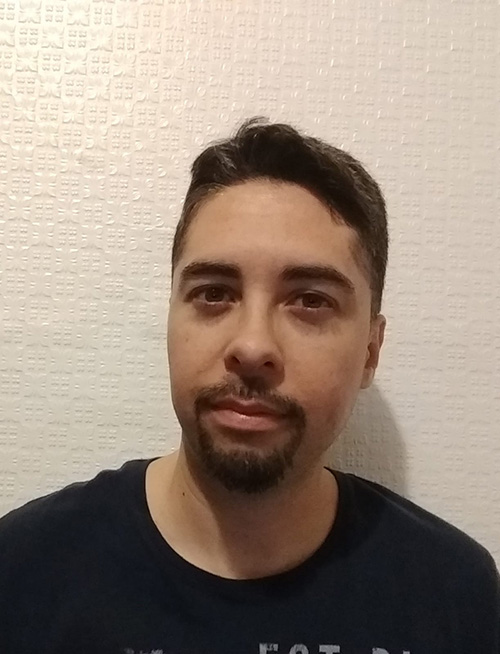
Diorge Souza
Postdoc
I’m interested in the evolution and function of the ESCRT-III superfamily. We have recently shown that this superfamily is also present in bacteria, and therefore ESCRT-III is found in all domains of life. We have been characterising ESCRT-III homologues present in several different archaeal and bacterial groups, and we hope to help to answer the most important question in the field, which is how these proteins remodel membranes.
*Equal contribution / #Corresponding authors
17. Oka GU, Souza DP, Cenens W, Matsuyama BY, Cardoso MVC, Oliveira LC, da Silva Lima F, Cuccovia IM, Guzzo CR, Salinas RK, Farah CS (2022) Structural basis for effector recognition by an antibacterial type IV secretion system. Proc Natl Acad Sci U S A 119(1):e2112529119.
16. Hatano T, Palani S*, Papatziamou D*, Souza DP*, Salzer R*, Tamarit D*, Makwana M, Potter A, Haig A, Xu W, Townsend D, Rochester D, Bellini D, Hussain HMA, Ettema T, Lowe J, Baum B#, Robinson NP#, Balasubramanian# (2021) Characterisation of the Ubiquitin-ESCRT pathway in Asgard archaea sheds new light on origins of membrane trafficking in eukaryotes. Biorxiv 10.1101/2021.08.17.456605.
15. Liu J*, Tassinari M*, Souza DP*, Naskar S*, Noel JK, Bohuszewicz O, Buck M, Williams TA, Baum B#, Low HH# (2021) Bacterial Vipp1 and PspA are members of the ancient ESCRT-III membrane-remodeling superfamily. Cell 184(14): 3660-3673.
14. Risa GT*, Fredrik F* et al., including Souza DP (2020) The proteasome controls ESCRT-III–mediated cell division in an archaeon. Science 369: eaaz2532.
13. Sgro GG*, Oka GU*, Souza DP, Cenens W, Bayer-Santos E, Matsuyama BY, Bueno NF, Dos Santos TR, Alvarez-Martinez CE, Salinas RK, Farah CS (2019)Bacteria-killing Type IV Secretion Systems. Frontiers in Microbiology 10: 1078.
12. Sgro GG*, Costa TRD*, Cenens W, Souza DP, Cassago A, Oliveira LC, Salinas RK, Portugal RV, Farah CS#, Waksman G# (2018) Cryo-EM structure of the bacteria-killing type IV secretion system core complex from Xanthomonas citri. Nature Microbiology 3(12): 1429-1440
11. Tamaki FK, Souza DP, Souza VP, Ikegami CM, Farah CS, Marana SR (2016) Using the Amino Acid Network to Modulate the Hydrolytic Activity of β-Glycosidases. PLoS ONE 11(12): e0167978.
10. Oliveira LC, Souza DP#, Oka GU, Lima FD, Oliveira RJ, Favaro DC, Wienk H, Boelens R, Farah CS#, Salinas RK# (2016) VirB7 and VirB9 interactions are required for the assembly and antibacterial activity of a type IV secretion system. Structure 24(10): 1707-1718.
9. Souza DP, Oka GU, Alvarez-Martinez, CE, Bisson-Filho AW, Dunger G, Hobeika L, Cavalcante NS, Alegria MC, Barbosa LR, Salinas RK, Guzzo CR, Farah CS (2015) Bacterial killing via a Type IV Secretion System. Nature Communications 6: 6453.
8. Souza DP, Andrade MO, Alvarez-Martinez, CE, Arantes, GM, Farah CS#, Salinas RK# (2011) A component of the Xanthomonadaceae Type IV Secretion System combines a VirB7 motif with a N0 domain found in outer membrane transport proteins. PLoS Pathogens 7(5): e1002031.
7. Caldas CA, Souza DP, Rodrigues MT, Maranhão AQ, Moro AM, Brígido MM (2007) Design approach regarding humanization and functionalization of an anti-CD18 monoclonal antibody. In: Rodney Smith. (Org.). Cell Technology for Cell Products. Dordrecht: Springer, 3: 451-454.
6. Souza DP, Silva SS, Baptista AJ, Nicola AM, Kyaw CM, Silva-Pereira I (2005) Paracoccidioides brasiliensis translation and protein fate machineries revealed by functional genome analysis. Genetics and Molecular Research 4(2):273-289.
5. Alegria MC, Souza DP, Andrade MO, Docena C, Khater L, Ramos CH, da Silva AC, Farah CS (2005) Identification of new protein-protein interactions involving the products of the chromosome- and plasmid-encoded type IV secretion loci of the phytopathogen Xanthomonas axonopodis pv. citri. Journal of Bacteriology 187(7):2315-2325.
4. Felipe MS et al., including Souza DP (2005) Transcriptional profiles of the human pathogenic fungus Paracoccidioides brasiliensis in mycelium and yeast cells. Journal of Biological Chemistry 280(26):24706-24714.
3. Albuquerque P, Baptista AJ, Derengowski Lda S, Procopio L, Nicola AM, Arraes FB, Souza DP, Kyaw CM, Silva-Pereira I (2005) Paracoccidioides brasiliensis RNA biogenesis apparatus revealed by functional genome analysis. Genetics and Molecular Research 4(2):251-272.
2. Reis VC, Torres FA, Pocas-Fonseca MJ, De-Souza MT, Souza DP, Almeida JR, Marinho-Silva C, Parachin NS, Dantas Ada S, Mello-de-Sousa TM, Moraes LM (2005) Cell cycle, DNA replication, repair, and recombination in the dimorphic human pathogenic fungus Paracoccidioides brasiliensis. Genetics and Molecular Research 4(2):232-250.
1. Felipe MS et al., including Souza DP (2003) Transcriptome characterization of the dimorphic and pathogenic fungus Paracoccidioides brasiliensis by EST analysis. Yeast 20(3):263-271.